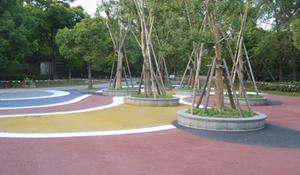Permeable Concrete (also known as Permeable Paving) is a new type of environmentally friendly pavement. The permeable surface has approximately 20% porosity, which can quickly replenish urban underground water resources during rain and absorb noise generated by vehicle traffic. The Permeable Paving surface can reduce the reflection of sunlight and heat from the ground, lowering surface temperatures and mitigating the “heat island effect.” Permeable Concrete can also provide filtration effects, preventing heavy metals from automotive and industrial emissions, tire wear, and industrial dust from directly flowing into rivers.
1. Permeable Concrete is layered for installation, mainly to save costs, typically using a plain colored base layer+ a colored surface layer structure. The surface layer uses colored Permeable Concrete, with a typical thickness of 3-5CM, using 5MM aggregate size for the pavement. The plain base layer generally uses pea gravel (commonly known as melon seed gravel) with an aggregate size of about 10MM, which helps to effectively reduce costs.
2. Permeable Concrete is also known as porous concrete, no-sand concrete, or colored permeable pavement. It is a type of porous lightweight concrete made from aggregate, cement, and water. It does not contain fine aggregates and consists of coarse aggregates coated with a thin layer of cement paste that bond together to form uniformly distributed voids, resulting in a honeycomb structure that is breathable, permeable, and lightweight.
3. The construction of Permeable Concrete mainly includes processes such as paving, forming, surface treatment, and joint treatment. Paving can be done using mechanical or manual methods; forming can be done using plate vibrators, vibrating leveling rollers, manual push-pull rollers, and vibrating leveling beams; surface treatment is primarily to enhance the appearance, and involves adjusting or cleaning the surface of the formed Permeable Concrete; the joint settings for the Permeable Concrete surface are basically the same as those for ordinary concrete, with contraction joints spaced evenly, and the distance should not exceed 6m.













